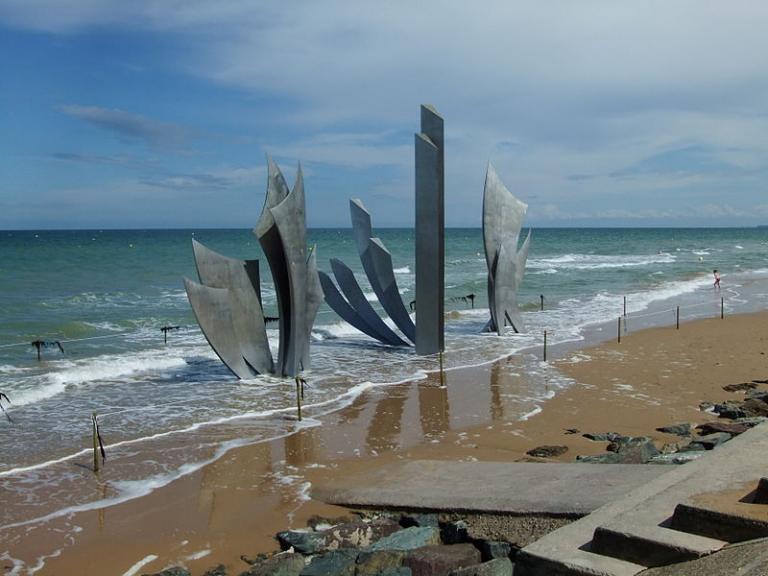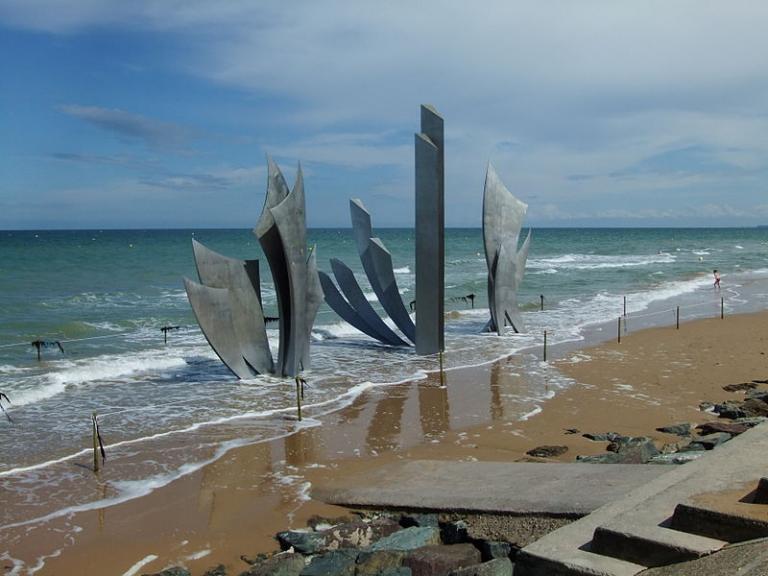
A couple years ago, I wrote about the event from a different perspective, that, having read Stephen Ambrose’s D-Day, I was struck by the fact that those soldiers tasked with taking Omaha Beach indeed suffered horrendous casualties, but that the remaining beaches — Utah, Gold, Juno, and Sword — were taken in a much more “textbook” fashion. To cite my prior post:
at Omaha Beach, due to winds and tide, the units landed in unplanned locations, and companies were split up and had to, in some fashion, re-form. Intelligence was faulty and there were more German troops, and the troops were more highly trained, than expected, and the pre-landing bombardment failed to soften up the targets.
What’s more, in a recent Facebook conversation, I learned that Omaha’s geography meant that it was always expected to be much harder to take than the other beaches. And the point of my prior post was that I was astounded at the level of planning, the sheer quantities of equipment — landing craft, tanks, munitions, and even the counterintelligence efforts (there was a whole ‘nother book about the effort in convincing Hitler and Rommel that the attack would come from Calais, not just the Potemkin village of tanks but the fact that all of the Nazi’s spies had been unmasked and were serving as double-agents sending reports that they were very certain that Normandy was just a feint), and the joining of forces with the British and Canadians, that made the landings a success.
But here’s the other thing that struck me: what the event says about leadership.
Ambrose titles his chapter on Omaha, “Visitors to Hell,” based on a quote from an interview with a Pvt. Harry Parley, “I became a visitor to hell.” He describes the men, having landed at the beach, in the wrong sector and separated from their units, and having left their landing craft not because of extraordinary bravery but because, well, what choice was there?, simply trying to find cover and stay alive, at the “shingle,” a hilly, gravel area that provided some modest protection.
But then he profiles the actions of Maj. Sidney Bingham, who survived the landing but whose company commanders were dead and whose group saw terrible casualties. Ambrose writes:
He set out to organize a leaderless group from F Company and get it moving up the bluff.
By this time, around 0745, unknown others were doing the same, whether NCOs or junior officers or, in some cases, privates. Staying on the beach meant certain death; retreat was not possible; someone had to lead; men took the burden on themselves and did. (p. 342).
Here are two other excerpts that I want to quote in detail:
All across Omaha, the men who had made it to the shingle hid behind it. Then Cota, or Canham, or a captain here, a lieutenant there, a sergeant someplace else, began to lead. They would cry out, “Follow me!” and start moving up the bluff.
In Sergeant Lewis’s case, “Lt. Leo Van de Voort said, ‘Let’s go, goddamn, there ain’t no use staying here, we’re all going to get killed!’ ‘The first thing he did was to run up a gun emplacement and throw a grenade in the embrasure. He returned with five or six prisoners. So we thought, hell, if he can do that, why can’t we. That’s how we got off the beach.”
That was how most men got off the beach. Pvt. Raymond Howell, an engineer attached to D Company, described his thought process. He took some shrapnel in helmet and hand. “That’s when I said, bullshit, if I’m going to die, to hell with it I’m not going to die here. The next bunch of guys that go over that goddam wall, I’m going to go with them. If I’m gonna be infantry, I’m gonna be infantry. So I don’t know who else, I guess all of us decided well, it is time to start. (p. 344 – 345.)
. . .
. . . the plan had failed, utterly and completely failed. . . .
Exhortation and example, backed by two years of training, got hte GIs from the 16th Regiment to overcome their exhaustion, confusion, and fear and get out from behind the shingle and start up the bluff. . .
Captain Dawson, Lieutenants Spaulding and Dillon, and many others provided the example; their actions proved that it was possible to cross the swamp, the antitank ditch, the minefields, and find paths to the top of the bluff.
As they came onto the beach, the junior officers and NCOs saw at once that the intricate plan, the one they had studied so hard and committed to memory, bore no relationship whatsoever to the tactical problems they faced. . . .
Yet their training had prepared them for this challenge. They sized up the situation, saw what had to be done, and did it. This was leadership of the highest order. It came from men who had been civilians three or even two year earlier.
Sgt. John Ellery of the 16th Regiment was one of those leaders. When he reached the shingle, “I had to peer through a haze of sweat, smoke, dust, and mist.” There was a dead man beside him, another behind him. Survivors gathered around him; “I told them that we had to get off the beach and that I’d lead the way.” He did. Whenhe got to the base of the bluff, he started up, four or five men following.
Quoting Ellery himself:
“I didn’t see any generals in my area of the beach, but I did see a captain and two lieutenants who demonstrated courage beyond belief as they struggled to bring order to the chaos around them.” Those officers managed to get some men organized and moving up the bluff. One of the lieutenants had a broken arm that hung limply at his side, but he led a group of seven to the top, even though he got hit again on the way. Another lieutenant carried one of his wounded men thirty meters before getting hit himself.
“When you talk about combat leadership under fire on the beach at Normandy,” Ellery concluded, “I don’t see how the credit can go to anyone other than the company-grade officers and senior NCOs who led the way. It is good to be reminded that there are such men, that there always have been and always will be. We sometimes forget, I think, that you can manufacture weapons, and you can purchase ammunition, but you can’t buy valor and you can’t pull heroes off an assembly line.” (p. 358 – 359).
That’s the end of my quotes. Now, a few words of comment:
We have, indeed, cheapened leadership. Every high school student’s resume, as they apply for college, is expected to be full of examples of leadership, and I recall a piece of advice that seems to be ubiquitous: “don’t list every activity you participated in; just give the ones in which you had a leadership role.” But not everyone is cut out to be a leader, as properly defined, which is why “leadership” gets watered down, to holding a “leadership job” such as treasurer or secretary, or even just, in my son’s National Honor Society application instructions, “leadership by participation,” which, whatever it might mean in someone’s formal “leadership theories” (e.g., this internet search result), meant in this case that they credited volunteer activities as “leadership” simply because they had defined NHS eligibility as requiring “leadership” and needed to enable non-leaders who were active participants, to be able to join.
And at our college visits, the student tour guides extolled how easy it was to get a new student club started — find a very small number of students who share this interest, apply, and get funding. And the websites loved to say just how many student clubs they had — and I wonder to what extent students were eager to start their own clubs, however few activities they may have engaged in, rather than participate in others which, by having greater numbers, could be more effective, because small student clubs offered more opportunities for claiming “leadership roles” on resumes.
But, when I think of my own role as Cub Scout Committee Chair, I am, on paper, a leader. In practice, I have done a fair amount of planning — scheduling out the scouting year, reserving outings at the nature center, the Lego Discovery Center, and so on. But I hide behind the Scoutbook e-mail system, and the fact that we don’t have a replacement Committee Chair could be laid at the feet of my lack of actual in-person leadership.
And that’s OK. Because the notion that everyone should be a Leader is also mistaken. These men were, in part, selected for their promise, but also were trained to be leaders, and with a degree of training that we would hardly expect in our civilian lives.
So it’s OK to be a follower — as long as one makes the right decisions about who one is to follow, of course.
Image: memorial at Omaha Beach; see Traces of War for a description. https://commons.wikimedia.org/wiki/File:M%C3%A9morial_omaha_beach,_plage_de_normandie.jpg; By Woolfer [CC BY-SA 3.0 (https://creativecommons.org/licenses/by-sa/3.0)], from Wikimedia Commons













